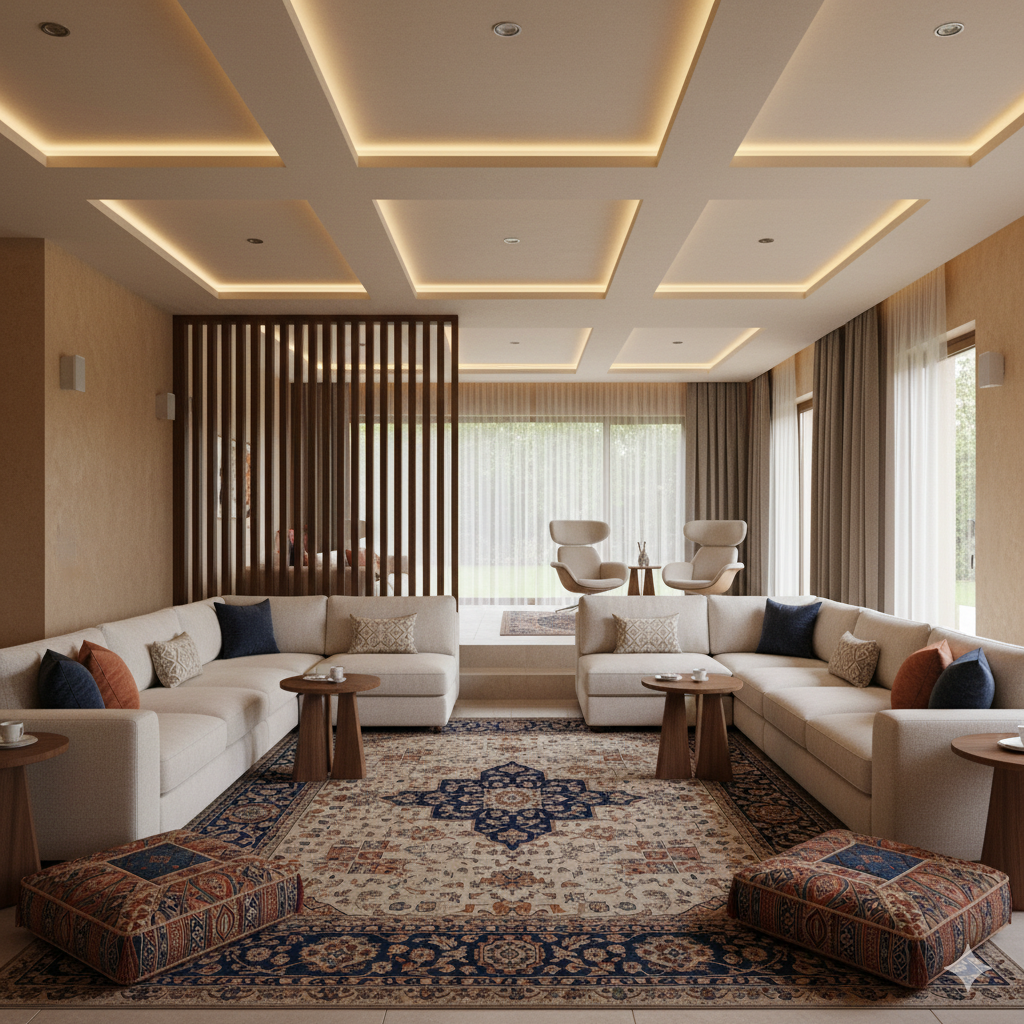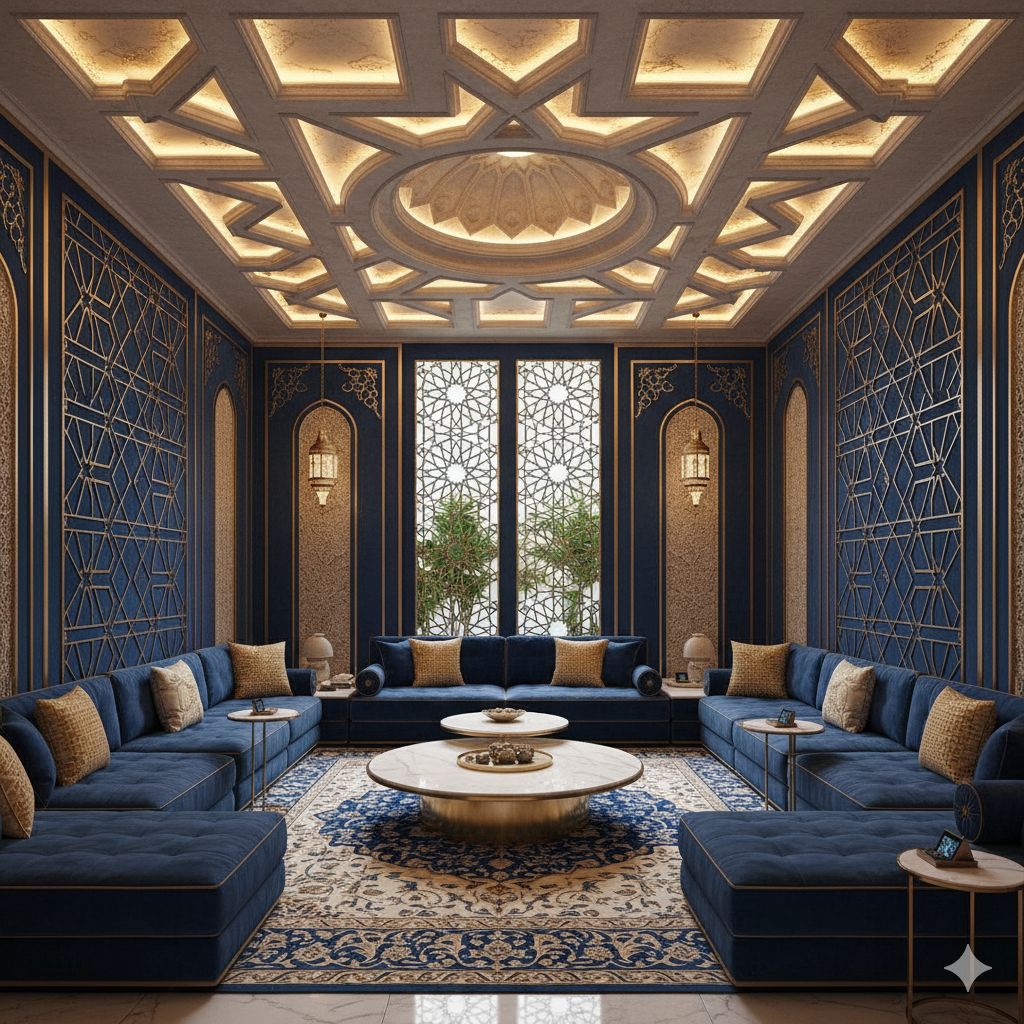Modern Majlis Design: Blending Tradition with Contemporary Comfort
The majlis has been the heart of Middle Eastern hospitality for centuries, serving as a sacred space where families gather, guests are welcomed, and important conversations unfold. Today’s homeowners seek to honor this rich cultural heritage while embracing contemporary lifestyle needs and design innovations. Creating a modern majlis that respects tradition yet functions for today’s families requires thoughtful planning, quality craftsmanship, and design expertise – qualities that leading firms like Antonovich Design, recognized as one of the best fit out companies for villas in Dubai, consistently deliver in their luxury residential projects.

Understanding the Modern Majlis Evolution
The traditional majlis was designed with specific cultural and social purposes in mind: a formal reception area, typically separated by gender, with floor seating arranged along the walls to facilitate conversation. Modern interpretations preserve the essence of these gathering spaces while adapting to contemporary living patterns. Today’s majlis often serves multiple functions—from formal entertaining to casual family movie nights – requiring flexible design solutions that don’t compromise on cultural authenticity.
Creating Flexible Gathering Spaces
Modular Seating Systems
The foundation of a flexible modern majlis lies in modular furniture that can be reconfigured based on the occasion. Unlike fixed traditional floor seating, contemporary modular pieces allow homeowners to:
- Adjust seating arrangements for intimate family gatherings or large celebrations
- Create conversation zones that can expand or contract as needed
- Incorporate both floor-level and raised seating options to accommodate different preferences
- Maintain the traditional perimeter seating layout while adding central ottomans or coffee tables
Premium modular systems now feature luxurious upholstery, hidden storage compartments, and integrated USB charging ports, seamlessly blending form with function.
Zoning Without Walls
Modern majlis design often employs subtle spatial divisions rather than rigid walls. This approach creates distinct areas for different activities while maintaining the open, welcoming atmosphere central to majlis culture. Techniques include:
- Strategic rug placement to define conversation areas
- Varying ceiling heights or treatments to delineate zones
- Decorative screens or mashrabiya panels that provide visual separation without blocking light or air flow
- Carefully positioned lighting to create intimate pockets within larger spaces
Updating Traditional Seating for Contemporary Comfort
Ergonomic Arabic Seating
While traditional floor cushions (Arabic jalsa) remain culturally significant, modern versions incorporate ergonomic principles for extended comfort. Contemporary designs feature:
- Higher-density foam cores that provide better lumbar support
- Backrest cushions with adjustable angles
- Armrests that can be added or removed based on the setting
- Fabric treatments that are stain-resistant and easy to maintain while retaining luxurious appearance
Hybrid Seating Solutions
Many modern majlis spaces now incorporate a mix of traditional and contemporary seating styles. This hybrid approach might include built-in bench seating along walls with plush cushioning, complemented by statement armchairs or low-profile sofas. This variety allows guests to choose their comfort level while maintaining the majlis aesthetic.
Integrating Smart Technology Seamlessly
Climate Control and Lighting
Advanced home automation transforms the majlis experience without disrupting traditional aesthetics. Smart systems allow hosts to:
- Adjust temperature zones for optimal comfort in different areas
- Program lighting scenes that transition from bright and welcoming during arrivals to warm and intimate during conversations
- Control natural light through automated curtains or smart glass technology
- Maintain air quality through integrated ventilation systems
These controls are typically concealed within traditional architectural elements or accessed via discreet wall panels and mobile applications.

Entertainment Integration
Modern families use the majlis for entertainment, requiring carefully integrated technology. Successful implementations include:
- Concealed projectors or retractable screens that disappear when not in use
- In-ceiling or in-wall speakers that provide immersive sound without visible equipment
- Hidden cable management systems
- Wireless charging surfaces integrated into coffee tables and side tables
The key is ensuring technology enhances rather than dominates the space, with all equipment carefully concealed when not in active use.
Material Selection for Modern Durability
Performance Fabrics with Traditional Aesthetics
Contemporary textile technology allows designers to specify fabrics that look traditionally luxurious while offering practical benefits:
- Velvet and silk-look materials with stain protection and fade resistance
- Geometric and arabesque patterns printed or woven onto high-performance backing
- Natural fibers treated for durability without sacrificing their organic appearance
- Removable, washable covers that maintain their shape and color
Sustainable and Low-Maintenance Materials
Modern majlis design increasingly incorporates sustainable choices that reduce maintenance:
- Engineered stone for flooring that mimics marble but requires less care
- LED lighting fixtures styled as traditional lanterns with minimal energy consumption
- Locally sourced wood treated for humidity resistance
- Water-based finishes and low-VOC materials for healthier indoor air quality
Color Palettes: From Traditional to Contemporary
While classic majlis design favored rich jewel tones and gold accents, modern interpretations expand the palette. Contemporary schemes might feature:
- Neutral bases (cream, beige, taupe) with traditional colors as accents
- Monochromatic approaches using varying shades of a single color family
- Earth tones that create calm, grounded environments
- Strategic pops of vibrant color through accessories that can be easily changed
The trend is toward creating timeless spaces that won’t feel dated, achieved through classic base colors enhanced by carefully chosen traditional elements.
Architectural Details That Honor Heritage
Contemporary Mashrabiya and Geometric Patterns
Traditional Islamic geometric patterns and mashrabiya (latticed screens) find new expression in modern majlis design through:
- Laser-cut metal or wood panels with traditional patterns
- Backlit geometric ceiling details
- Glass partitions etched or printed with arabesque motifs
- 3D wall panels that create depth and visual interest
These elements provide cultural continuity while being executed with contemporary precision and materials.
Ceiling Treatments
The majlis ceiling offers opportunities for dramatic design statements. Modern approaches include:
- Coffered ceilings with integrated lighting
- Fabric-stretched ceiling systems that soften acoustics
- Exposed beam designs stained in rich tones
- Sculptural plaster work combining traditional and contemporary forms

Practical Layout Considerations
Traffic Flow
Successful modern majlis design accounts for movement patterns:
- Clear pathways from entry to seating areas
- Service access that doesn’t disrupt conversations
- Emergency egress that meets code while maintaining aesthetic integrity
- Sufficient circulation space between seating groups
Acoustics and Privacy
Large gathering spaces require careful acoustic planning. Solutions include:
- Fabric wall treatments that absorb sound
- Strategic carpet placement
- Acoustic panels disguised as decorative elements
- Sound masking systems for spaces requiring privacy
Connecting Indoor and Outdoor Spaces
Many contemporary villas extend the majlis concept to outdoor areas, creating covered terraces with a similar design language. These transitional spaces feature:
- Weather-resistant furniture in traditional styles
- Outdoor majlis seating with all-weather cushions
- Pergolas or retractable awnings for shade
- Outdoor heating and cooling elements for year-round use
This indoor-outdoor connection aligns with traditional Arabian architecture’s emphasis on courtyards and shaded outdoor rooms.
Personalization and Cultural Expression
The most successful modern majlis designs reflect the homeowner’s personal story while honoring cultural traditions. This might include:
- Displaying family heirlooms alongside contemporary art
- Incorporating travel souvenirs into the design scheme
- Using textiles or artifacts from the family’s region of origin
- Creating custom furniture pieces that tell a unique story
Maintenance and Longevity
A well-designed modern majlis balances beauty with practicality. Considerations for lasting quality include:
- Choosing timeless design elements over trendy details
- Specifying commercial-grade fabrics for high-traffic areas
- Installing easily cleanable surfaces in food service zones
- Planning for technology updates without major renovations
—-
The modern majlis successfully bridges centuries of tradition with contemporary living requirements. By thoughtfully incorporating modular furniture systems, smart technology, and performance materials while respecting cultural heritage, designers create spaces that serve today’s families without abandoning their roots. The key lies in understanding that modernization doesn’t mean westernization—it means adapting timeless principles of hospitality and gathering to contemporary needs. Whether hosting formal occasions or casual family time, the modern majlis remains what it has always been: a welcoming space where connections are forged and memories are made, now with the comfort and convenience that modern life demands.
When planning your modern majlis, consider working with experienced designers who understand both the cultural significance of these spaces and the technical requirements of contemporary living. The investment in thoughtful design pays dividends in a gathering space that serves your family for generations.
